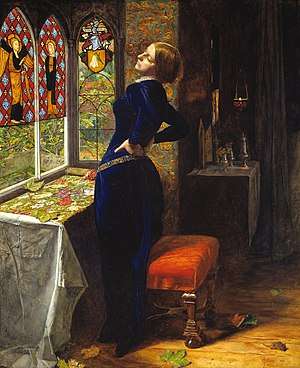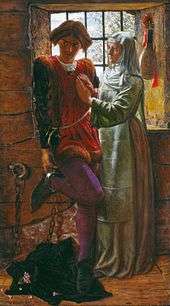Mariana (Millais)
Mariana is an 1851 oil-on-panel painting by John Everett Millais. The image is based on the solitary Mariana from William Shakespeare's Measure for Measure, written between 1601 and 1606. In the play, Mariana was to be married, but was rejected when her dowry was lost in a shipwreck. Her story was retold in "Mariana", a poem published in 1830 by Tennyson, which provided additional inspiration for Millais's painting. The painting is regarded as an example of Millais's "precision, attention to detail, and stellar ability as a colorist".[1]
| Mariana | |
|---|---|
 | |
| Artist | John Everett Millais |
| Year | 1851 |
| Medium | Oil on panel (mahogany) |
| Dimensions | 59.7 cm × 49.5 cm (23.5 in × 19.5 in) |
| Location | Tate Britain, London |
Millais was a founding member of the Pre-Raphaelite Brotherhood, a group of English artists who came together in 1848 with the goal of renewing British painting. They found in the art of the early Italian Renaissance—before Raphael—a sincerity of purpose and clarity of form that they sought to emulate.[2]

Pre-Raphaelites frequently used allegorical images to create a narrative to teach a moral virtue or virtues. Sometimes they used contemporary literature as inspiration for their paintings, which often include numerous details that allow the viewer to "read" the painting. Millais used Tennyson's poetry to create a narrative for his painting of Mariana and he wanted to allow the viewer familiar with Tennyson's poetry to read the entire poem through the painting.
When it was first exhibited at the Royal Academy in 1851, the display caption contained lines from Tennyson's "Mariana" (1830):
She only said, 'My life is dreary,
He cometh not,' she said;
She said, 'I am aweary, aweary,'
I would that I were dead!'
The painting is packed with details that help the viewer to read the narrative of the work along with Tennyson's poetry. Everything from the rolled embroidery that Mariana has been working on and the leaves outside of the window point the reader in the direction of the narrative which is about a young woman rejected by her fiancé because her dowry was lost at sea. It is about waiting and the passage of time, which Millais shows by the arched-back pose of the woman. The pose makes it seem like she has been sitting too long and she must stand up to stretch before she sits again. The rolled embroidery on the table gives the viewer a clue as to how long Mariana has been working on it.
In the painting, Millais included many details that relate directly to Tennyson's poetry. One example is the curtain. In the poem, Tennyson wrote: "When thickest dark did trance the sky, She drew her casement-curtain by, and glanced athwart the glooming flats".[4] Although there is not a curtain in Millais's painting, this line is similar to the scene that is presented outside of the window. The viewer perceives an ominous feeling, just like the dark storm that Tennyson alludes to in the line above. The little mouse that is on the floor towards the bottom right corner is a detail that Millais took from Tennyson's poem: "the mouse behind the mouldering wainscots shriek'd or from the crevice peer'd about". Together, Millais's painting and Tennyson's poem create an intriguing storyline for the reader to follow.[4]
References
- King, Sally. ""Aweary" and Waiting: John Everett Millais's Mariana". English 156 / History of Art 152, Brown University, 2007. Retrieved 21 October 2007.
- Treuherz, J. (2003). Pre-Raphaelitism. Grove Art Online.
- Fowle, Frances (December 2000). "Sir John Everett Millais, Bt Mariana 1851". The Tate. Retrieved 22 January 2013.
- Tennyson, Alfred (1965). Poems and Plays. London: Oxford University Press.
- "Millais's Mariana". Smarthistory at Khan Academy. Retrieved 22 January 2013.
Sources
- Mariana 1851. Tate Gallery display caption, July 2007.
- Millais: An Exhibition Organized by the Walker Art Gallery Liverpool and the Royal Academy of Arts London, January–April 1967. London: William Clowes and Sons, 1967.